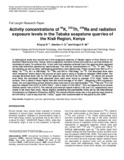Activity concentrations of 40K, 232Th, 226Ra and radiation exposure levels in the Tabaka soapstone quarries of the Kisii Region, Kenya
Abstract
A radiological study was carried out in the soapstone quarries of Tabaka region of Kisii district in the Southern Nyanza province, Kenya, where soapstone has been mined and used as a carving medium for hundreds of years. To achieve this, 14 soil and rock samples collected from five quarries were analyzed using high-resolution gamma-ray spectroscopy. The activity concentrations of 232Th, 40K and 226Ra in the samples as well as other radiological parameters were determined. These ranged from 38.6 to 271.7 Bqkg-1 for 232Th, 43.1 to 360 Bqkg-1 for 226Ra, and 245 to 1780 Bqkg-1 for 40K. The absorbed dose rates were measured 1metre above the ground at each quarry using a Canberra radiagem 2000 model. The average absorbed dose rate for the five quarries was found to be 541.4 nGyh-1 1m above the ground level while the calculated total absorbed dose rates were found to average 177.6 nGyh-1 below the surface. This is about 4 times higher than the world average of 43 nGyh-1. Assuming a 40% occupancy factor, the corresponding annual effective dose rates due to the radionuclides 232Th, 226Ra and 40K in the quarries ranged from 0.215 to 0.875 mSvy-1, with a mean of 0.44 mSvy-1. This corresponds to an excess lifetime cancer risk of 0.07%. The internal and external hazard indices (1.03 and 1.27, respectively) were found to be more than unity, hence slightly exceeding the permissible limits set by the International Commission on Radiation Protection (ICRP). The annual effective dose rate in the quarries was found to be 0.44 mSvy-1 and is less than the 1 mSvy-1 upper limit recommended for the public by the ICRP.
URI
http://hdl.handle.net/123456789/65https://www.ajol.info/index.php/ajest/article/viewFile/72067/61011
Collections
- Journal Articles (PAS) [303]

